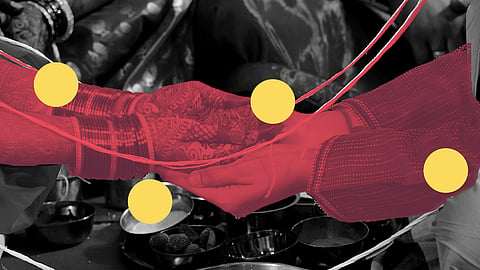

For the world, Indian weddings are all about the fairy-tale-like, four-day-long extravaganza. As the new Netflix original 'The Big Day' suggests, - glamorous bride and groom, dolled-up baratis, and an overall larger than life celebration are what define an Indian wedding. From afar, it is nothing but a real-life movie. But when you are a part of the wedding, you realise that our traditions are often questionable (possible wrong) and misogynist in nature.
Bollywood actress Dia Mirza made the news in February this year after denying to follow some of these customs at her wedding. Mirza chose a female priest and said no to Kanyadaan; in an attempt towards equality. Following this, the media flooded with a plethora of stories about women matching these choices. In a recent case, Bollywood actress Alia Bhatt questioned the the tradition of ‘kanyadaan’ in a bridal ad for Mohey. This too recieved a lot of backlash on social media. But has Indian society always been so regressive? Our history has innumerable examples of women warriors, leaders and activists who boasted featly achievements. And yet, there are also instances where women fight for equality. So what was the reason behind this misogynist ideology?
The Bridge Chronicle tried to trace the origin, history and timeline of the most argued custom in Indian wedding — Kanyadaan. We spoke to Dr Manisha Shette of Jnana Prabodini, Pune, to understand the concept better. The doctor has been practising priesthood for the last thirteen years and also trains aspiring priests. She is associated with the Sanskrit language, culture and research department of the institution. She talks about how the original concept of Kanyadaan changed over the years.
"According to the original scriptures, Kanyadaan was always a moral concept, versus the tone it has today. It was about the groom publically accepting the bride and making a promise to respect her and treat her equal in all manners," said the priestess.
She explained that the change in the concept can be traced back to the varying social conditions. In the Vedic period, women had the right to pursue an education and then chose to marry or stay single. But with the change in the social systems, the conditions that women were married in changed. With the rise of class, caste and other factors - there was a rise in child marriage which led to seeing the girl-child as a "burden" to the parents. Hence, the false notion of kanyadaan set in. Additionally, the tradition of giving secret jewellery/cash to the bride later took the form of dowry.
"But originally, kanyadaan revolved around the concept of acceptance. The parents of the bride asking the husband to promise (that) the family will respect, love and care for the girl like their own."
During the discussion, we also touch upon other traditions — washing the groom's feet, wearing mangalsutra or bangles — and questioned their origin.
"The Vedas do not talk about wearing any ornament to signify that a woman is married. These are more recent. Even the tradition of washing the groom's feet can be traced back to older times. The groom and their families would usually come to the bride's village after a long journey on foot or otherwise. Hence offering water to clean their feat was necessary. But now, when everyone travels in cars, there is no need for it," said Shette.
Recent discussions on the matter show that women are now actively working towards abolishing these archaic traditions. Moreover, while we struggle for the concept of love and marriage to become more inclusive, how do we fit these customs and traditions?
We asked some people to share their experiences on the matter.
Mumbai-based Shreya, is set to be married in December. To her surprise, her in-laws were okay with doing away with kanyadaan, but her parents were adamant. "I couldn't believe it when my family tried to convince me otherwise. They believed it was one of the "meritorious" things to do. It was my mother-in-law who managed to talk them out of it," she said.
Luckily for some, the discussion isn't that difficult. Harsh Varma recalls his wedding and the talk about kanyadaan. "We had not thought about the matter until my younger sister pointed it out. She asked my mother why was it necessary to give the girl as a donation. (she had tried to break down the word into kanya-daan.) Thankfully, everyone agreed to not doing it."
Countering the point of view, Mr Rajat says, "Since we were young, we have seen marriage ceremonies in a certain way. People believed that "kanyadaan" is an honour, many are not fortunate to have. So I wished to fulfil this desire at my daughter's wedding."
Talking about the changes over the year, Dr Manisha Shette said, "I have seen an increase in women priestesses. There has also been an increase in the number of people choosing to do away with misogynistic systems."
Sharing an instance, she said, "We conducted a wedding where we conducted "putradaan." The bride made all the promises that a man makes during the wedding. It was good to see such acceptance."
"Sadly, acceptance isn't high enough in rural areas. But education is the key. That is when people will be able to make informed choices," added Shette.
Traditions and logic have been at warring heads in India for a long time. Whether one believes in the system or not is a matter of personal choice. But it is imperative to make an informed choice. India is trying to adopt a logical and progressive outlook, and each small effort can make a huge difference.
